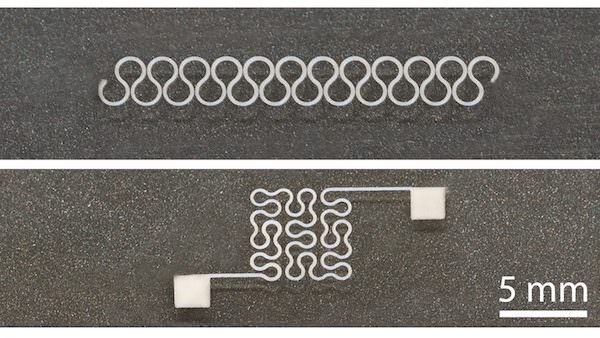
[Image above] Two printed silver nanowire patterns, horseshoe and Peano curve, with high resolution. Credit: North Carolina State University
Advancements in electronics have led to some pretty cool research in the areas of flexible electronics. To wit:
A couple of years ago, Rice University researchers discovered that metallic borophene used on an elastic surface could preserve its stretchability while maintaining electronic properties.
Last year, a collaboration of Harvard University and Air Force researchers developed a 3-D printing technique to create “stretchable, wearable electronic devices.”
Researchers at Harvard recently 3-D printed silver nanoparticles that could be useful for electronic sensors and wearable devices.
And now, researchers at North Carolina State University have invented a process that uses silver nanowires to print electronic circuits on flexible surfaces. Unlike nanoparticles, nanowires are more conductive and flexible, with less tendency to break.
But the downside is that silver nanowires tend to clog the nozzle of a 3-D printer, according to a NC State news release.
The researchers solved this issue, however, using electrohydrodynamic printing, a process that uses an electric field to extrude silver nanowire “ink,” according to the paper’s abstract.
“Our approach uses electrohydrodynamic printing, which relies on electrostatic force to eject the ink from the nozzle and draw it to the appropriate site on the substrate,” Jungian Dong, associate professor in NC State’s Edward P. Fitts Department of Industrial & Systems Engineering, says in the release.
Scientists have experimented with silver nanowires in the past—for circuits in RFID tags used in packaging, layered with graphene for less breakable smartphone touchscreens, and even in the development of smart windows.
Team member Yong Zhu, a professor of mechanical engineering at NC State, has been studying silver nanowires for the past several years—in elastic conductors, wearable sensors, and electronic sensors to monitor skin hydration.
The “ink” the team used is a mix of solvent and silver nanowires >20 μm long, which gives the circuits the “desired conductivity, flexibility, and stretchability,” Zhu explains in the release.
“The solvent we use is both nontoxic and water-soluble,” Ph.D. student and lead author of the paper Zheng Cui adds. “Once the circuit is printed, the solvent can simply be washed off.”
Examples of prototypes the team developed include a glove heater and a wearable electrode that can be used in electrocardiography. Zhu says there are other uses for the research, including “healthcare monitors (e.g., heart rate, blood pressure), activity trackers, human-machine interfaces, electronic skins, and wearable displays,” he writes in an email. The university has filed a provisional patent and Zhu says the research can be scaled for manufacturing.
“Given the technique’s efficiency, direct writing capability, and scalability, we’re optimistic that this can be used to advance the development of flexible, stretchable electronics using silver nanowires—making these devices practical from a manufacturing perspective,” he says in the release.
“Most of the existing electronics are rigid,” Zhu adds. “Our research makes electronics flexible and stretchable, printed with high resolution and in large scale.”
The paper, published in Nanoscale, is “Electrohydrodynamic printing of silver nanowires for flexible and stretchable electronics” (DOI: 10.1039/C7NR09570H).
Did you find this article interesting? Subscribe to the Ceramic Tech Today newsletter to continue to read more articles about the latest news in the ceramic and glass industry! Visit this link to get started.
Author
Faye Oney
CTT Categories
- Basic Science
- Biomaterials & Medical
- Electronics
- Manufacturing
- Nanomaterials


